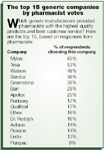Exclusive survey of R.Ph.s reveals their hopes, fears about generics
This article for the generic supplement highlights findings of an exclusive survey conducted by Advanstar for Drug Topics.
Two-thirds of the drugs that go out the door of the nation's pharmacies are generics. That's the conclusion of an exclusive Drug Topics survey of pharmacists on the subject of generics. The Medicare drug plan, lower consumer costs, patient requests, and higher pharmacy profits are why pharmacists are dispensing more generics than ever before.
"Plans are requiring generic dispensing, as more and more get released to the market," said one of the 264 pharmacists who took our online survey in February. "Thirty-five years ago pharmacists were faced with the ominous responsibility of encouraging the use of generic drugs," said another R.Ph. "I was afraid to kill the goose that laid the golden egg. I was wrong. The goose just began laying eggs much faster."
More than nine out of 10 respondents (93%) said they have experienced an increase in the sale of generics in their pharmacy. Most of the respondents, from all over the country and in every work setting, see this as a persistent trend. They report that generics accounted for 59% of prescriptions in 2006 in their pharmacy, but grew to 66% in 2007.

Paradoxically, although 65% of the responding pharmacists said patient requests were a significant factor in deciding to substitute a generic, almost an equal percentage (63%) said patient resistance was a major barrier to substitution. Of equal concern to pharmacists are brand manufacturers' efforts to stall generic introductions (63% listed it as a barrier to utilization). And 39% said physician resistance was a factor. A little over a third (34%) said brand rebates to managed care organizations was also a problem.
Respondents were very clear on how to overcome these barriers. Eight out of 10 respondents said that waiving or lowering copays for generics is the most effective way to increase substitution rates. Then 74% mentioned penalizing patients with a higher copay when they request a brand. Over a third (38%) said that increasing physician and pharmacist incentives was one of the best ways to increase substitution rates. "And patient education is very important," said one respondent.
Only 30% of respondents' pharmacies offer certain generics at no or low cost to patients; more than two-thirds (68%) don't. But of those who do, 67% said it is good for business.